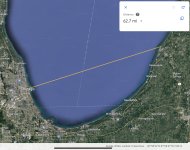MossRoad
Super Moderator
- Joined
- Aug 31, 2001
- Messages
- 60,281
- Location
- South Bend, Indiana (near)
- Tractor
- Power Trac PT425 2001 Model Year
Not so much a nature photo as a landscape photo, but here you go.
This view is from Rocky Gap County Park just north of St. Jospeh, MI in Benton Harbor, MI. It holds a special place in my heart. When I was a kid in the 60s, my parents would load us all up in the VW van and we'd head up here, about a 35-40 mile drive. It had these metal breakwaters sticking out into the lake. Probably a dozen or so down the shore. They used to be topped with wood. They were intended to stop beach erosion, but it has been determined in recent years that they actually rob sand further down the shoreline. There are many large conglomerate rocks along the shore, below where I'm standing, hence the park name.
Many times we'd go there, and the dead fish, alewives, were 10-20 feet thick and the beach was unusable. Fish kills were something in the 60s.
We'd go to this beach, because it was (and still is) free.
I almost died at this beach when I was maybe 4 years old. I stepped off of a sandbar when a wave hit me, and went under. I remember the feel of the pebbles and coarse sand rolling against my body, the sunlight above me and my face getting ground into the sand over and over again. I breathed in a slug of water, and it hurt very bad. I was flailing around under there for quite a while when someone grabbed me and pulled me out. They carried me back to shore and put me on a blanket and I coughed up a lot of water. I remember it hurt to breath deeply for about a week after that.
It gave me a fear of water so terrifying that I wouldn't go into a lake, swimming pool, or bathtub until I was 8. I'd literally scream if my parents tried to get me in the tub. So I'd use a washcloth and dishpan when I needed to bath, and wash my hair in the sink, but only if forced.
Surprisingly, an older kid, about 16-17 years old, got me over my fear of water and I eventually became a lifeguard, water safety instructor, and whitewater rescue swimmer. So go figure?
When I started dating my wife, we'd go up to this beach about every evening in the summer, and well into our marriage. We still go by here a couple times a year and always stop by to have a look.
A few years ago, we caught a Monarch Butterfly southerly migration in the fall. Always something different.
On rare, clear days, you can see the top of the Chicago Skyline just poking over the horizon.
(click to enlarge)

This view is from Rocky Gap County Park just north of St. Jospeh, MI in Benton Harbor, MI. It holds a special place in my heart. When I was a kid in the 60s, my parents would load us all up in the VW van and we'd head up here, about a 35-40 mile drive. It had these metal breakwaters sticking out into the lake. Probably a dozen or so down the shore. They used to be topped with wood. They were intended to stop beach erosion, but it has been determined in recent years that they actually rob sand further down the shoreline. There are many large conglomerate rocks along the shore, below where I'm standing, hence the park name.
Many times we'd go there, and the dead fish, alewives, were 10-20 feet thick and the beach was unusable. Fish kills were something in the 60s.
We'd go to this beach, because it was (and still is) free.
I almost died at this beach when I was maybe 4 years old. I stepped off of a sandbar when a wave hit me, and went under. I remember the feel of the pebbles and coarse sand rolling against my body, the sunlight above me and my face getting ground into the sand over and over again. I breathed in a slug of water, and it hurt very bad. I was flailing around under there for quite a while when someone grabbed me and pulled me out. They carried me back to shore and put me on a blanket and I coughed up a lot of water. I remember it hurt to breath deeply for about a week after that.
It gave me a fear of water so terrifying that I wouldn't go into a lake, swimming pool, or bathtub until I was 8. I'd literally scream if my parents tried to get me in the tub. So I'd use a washcloth and dishpan when I needed to bath, and wash my hair in the sink, but only if forced.
Surprisingly, an older kid, about 16-17 years old, got me over my fear of water and I eventually became a lifeguard, water safety instructor, and whitewater rescue swimmer. So go figure?
When I started dating my wife, we'd go up to this beach about every evening in the summer, and well into our marriage. We still go by here a couple times a year and always stop by to have a look.
A few years ago, we caught a Monarch Butterfly southerly migration in the fall. Always something different.
On rare, clear days, you can see the top of the Chicago Skyline just poking over the horizon.
(click to enlarge)
